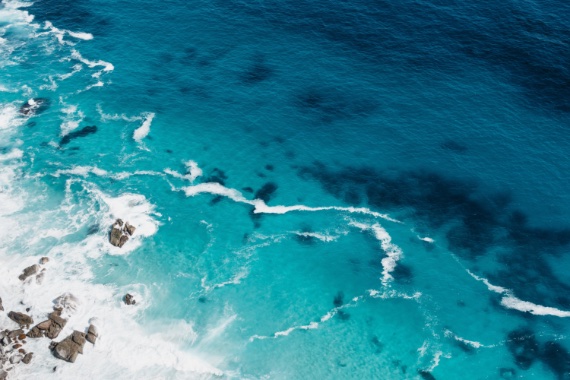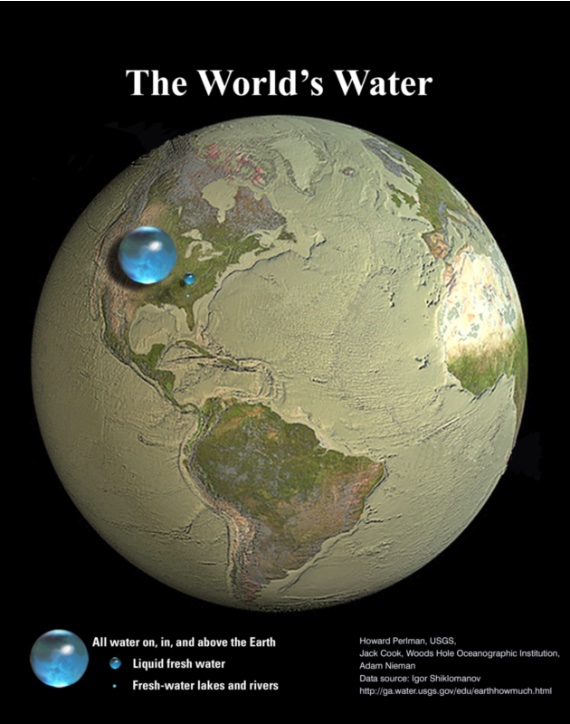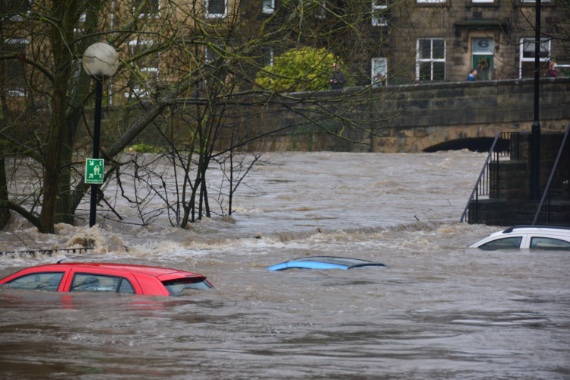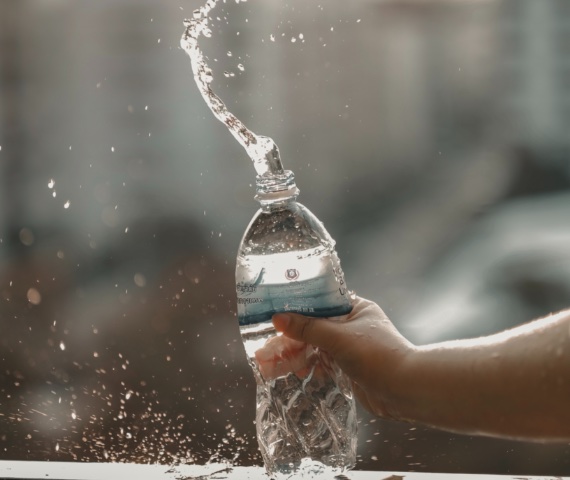When scientists study the habitability of other star systems, there is a sine qua non condition—not sufficient, but essential for the planet in question to be a candidate for the existence of life: can liquid water exist? We know that some forms of life do thrive without the need for oxygen or light, but not without water. Although science fiction and speculation have imagined other non-aqueous biochemicals in conditions very different from those on Earth, they have yet to be shown to be viable. But at least here on Earth, water is the first requirement for this to remain a living planet. So if we are talking about a necessary transition to a more sustainable world, water is at the top of the list of essential resources that we must protect to ensure our survival and that of all life on Earth.

And yet, if we look at the published data, anyone would think that we are in dire straits of running out of this essential resource: 1,500 litres of water are used to produce a kilo of grain, 10 times more if the kilo is meat, between 400 and 11,000 litres to obtain a litre of milk, and even a crop as basic to humanity as rice uses water at a rate of 3,400 litres per kilo (with estimates varying from just under 3,000 litres to 5,000). The food we each consume every day requires an average of 3,000 litres of water, rising to 9,000 for US citizens. But it’s not just about food production: making a cotton shirt uses almost 3,000 litres of water, or nearly 4,000 litres for jeans. This is what is known as virtual water, as opposed to the real water we consume directly.
With such dizzying figures, and with the world’s population approaching eight billion and rising, it seems we are heading inexorably towards a water apocalypse in which we will soon have no water to produce food or consumer products, or even to drink. In the style of the carbon footprint calculators that have proliferated on the Internet, there are also similar calculators for estimating the water impact of our lives and activities. And anyone curious enough to check their water footprint will find themselves assigned a figure of thousands of litres, almost just by existing.
An indestructible renewable resource
But just as experts have their reservations and misgivings about carbon footprint calculators, they also warn about water footprint calculators. It’s not that the figures—which can vary greatly in their estimations—are wrong, but rather that the concepts themselves are flawed; it must be understood what we are talking about when we quote the thousands of litres needed to produce such-and-such product. According to Judith Thornton, Low Carbon Manager at Aberystwyth University (UK), “the reality is that the concept of footprints cannot be used for water in a way that is environmentally meaningful”. “Water footprints lack scientific validity, and don’t actually tell us anything very useful about the environmental impact of water use,” she adds.

Overlaying all this data is an obvious basic scientific principle: water is neither created nor destroyed, and thus the amount of water we have today on Earth is the same as we have had in the past and will have in the future—some 1.386 billion cubic kilometres. Though an enormous quantity, when shown compared to the volume of the Earth it looks like a single drop, as seen in the image created by scientists from the US Geological Survey and the Woods Hole Oceanographic Institution. This includes all the planet’s water, from that which covers 71% of the Earth’s surface to that which lies locked deep underground, from the water frozen in the polar ice caps to the liquid contained in our very bodies. The vast majority of this total, almost 97%, is salt water; of the remaining fresh water, 68% is trapped in ice and glaciers. Liquid freshwater appears in the picture of the Earth as a tiny drop with a volume of just over 10.6 million km3. But 99% of this is underground; if we restrict ourselves to what is available to us in rivers and lakes, it is a barely distinguishable speck on the image, with a volume of only 93,000 km3. So, yes, water is a scarce and precious resource.
But also one that we will never lose because it is a renewable resource; water circulates through the hydrological cycle, alternating between its liquid, solid and gaseous states, between the oceans, the Earth’s surface and its interior. Scientists use this cycle to classify three types of water footprint: green refers to the consumption of rainwater, blue to groundwater or surface water, and grey accounts for the volume of water needed to dilute pollutants so that the resulting water meets water quality standards.
Humanity’s water footprint
In 2011, researchers at the University of Twente (the Netherlands) published a study aimed at quantifying humanity’s water footprint in high resolution. For the period 1996 to 2005, the result is an average of 9,087 km3 per year, i.e. roughly equivalent to one tenth of all the water in the world’s rivers and lakes. Of this footprint, 74% is green, 15% grey and 11% blue. In other words, the vast majority of this water footprint is rainwater. On average per person, each human being uses 1,385 m3 of water per year.
By sector, 92% of the total water footprint is accounted for by agriculture and livestock; food production is also a major emitter of greenhouse gases (GHG), but in terms of water use it is the biggest culprit. Averaging the figures at the global consumer level, it turns out that cereals have the largest water footprint impact, at 27%, ahead of meat (22%) and milk (7%). However, this apparent discrepancy with the data quoted above is due to the fact that global cereal consumption is much higher. In a direct comparison of different diets produced in 2018 by researchers at the European Commission, eating less meat and more fish and vegetables can reduce the water footprint by up to 55% in the case of a vegetarian diet. Other calculations agree that alternatives to animal products save water: the production of soya milk consumes just over a quarter of the water of cow’s milk; almond milk, rice milk or oat milk also require considerably less water.
:

Among other activities, electricity and heat production is another thirsty sector: one study estimated a water footprint of 378 km3 per year, more than five times the global household consumption (drinking, preparing food, bathing, washing clothes and dishes, flushing toilets etc.), with hydropower being the energy source with the largest footprint and wind power having smallest impact. Among manufacturing industries, the textile sector stands out with its 93 km3 of water consumed per year and the generation of 20% of all wastewater on the planet. Thus, food, energy and clothing account for the vast majority of each household’s water footprint, 94% (virtual water), compared to only 6% for the actual water we use directly.
The unsustainability of water resources
Despite all this, and even accepting that the assumptions of the studies can lead to large variability in the data—such as the estimates of the water footprint of milk—the most vocal experts object to the interpretation of the results: implying that production changes can achieve equivalent reductions in the water footprint, as is the case for GHG emissions, is misleading, they say. According to emissions and climate change experts Aaron Simmons and Annette Cowie of the University of New England, switching to crops with a smaller water footprint may not result in the smallest environmental water savings if, for example, irrigation rights can be bought and sold, as is often the case.
Thornton points out that if an industry consumes water and returns it treated to the source, its effective water footprint would be zero, while forests remove a lot of available water from the environment, all of which calls into question the very concept. According to water engineer Mike Muller of the University of the Witwatersrand (South Africa), relying on the water footprint concept to regulate “could leave poor people poorer and more vulnerable” if individual and local needs are not addressed. This is why initiatives are emerging such as the Alliance for Water Stewardship, which focuses on activity- and location-specific measures that take into account local conditions.

There is no doubt or disagreement about the need to value and use this precious resource sparingly. Innovative technologies are trying to make it more accessible where it is lacking, but it is not just a question of misallocation: as the sixth assessment report of the Intergovernmental Panel on Climate Change (IPCC) warns, global warming is intensifying the water cycle at a faster rate than expected, leading to an increased risk of torrential rains and floods. A 2022 study warns that the pressure on green water caused by climate change has already exceeded safe planetary boundaries, and that we are therefore in a dangerous situation of unsustainable water resources. “Humanity is no longer in the safe zone,” the authors conclude. “Immediate action is needed to maintain a resilient and nourishing freshwater cycle.”
From the tap or in a bottle?
As consumers, we all know the basic steps to save water in our own little patch of land, such as not leaving the taps or shower running, washing dishes in an efficient dishwasher or collecting rainwater for irrigation. But there is a classic debate that directly involves all of us, and in which legitimate claims are often mixed with those of advertising: drinking tap water or bottled water?

Unfortunately, a large part of humanity does not have a choice; more than two billion people still lack access to safe drinking water. But for those of us who do have a choice, there is no doubt. According to International Water Association Publishing, bottled water has its own water footprint—3 to 4 litres of water to make less than one litre—plus the energy consumed, the transport, the pollution and the materials such as plastic. Not to mention the fact that bottled water can be up to 2,000 times more expensive than tap water.
In 2021, a pioneering study led by ISGlobal in Barcelona gave us some concrete figures: the impact of bottled water on ecosystems throughout its life cycle is 1,400 times greater than tap water, and its impact on resources is 3,500 times greater. The authors also analyse the health impact of the low levels of trihalomethanes produced by the treatment of tap water with chlorine, which have been associated with bladder cancer; according to the data, their actual average effect on the life expectancy of the population is a reduction of… 2 hours of life.
Javier Yanes
Comments on this publication